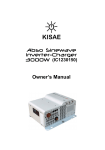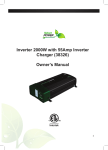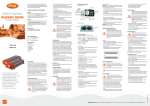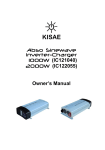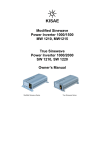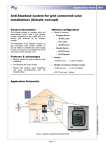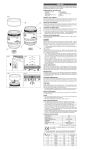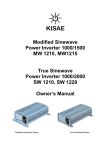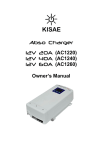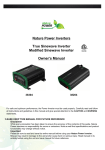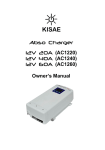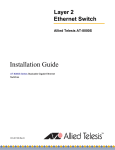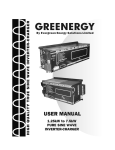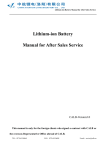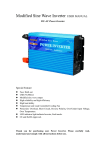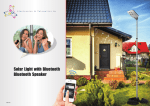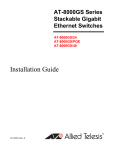Download Kisae America Car Batteries User Manual
Transcript
Abso Sinewave Inverter-Charger 3000W (IC1230150) Owner’s Manual For safe and optimum performance, the KISAE Abso Inverter-Charger 3000 must be used properly. Carefully read and follow all instructions and guidelines in this manual and give special attention to the CAUTION and WARNING statements. PLEASE KEEP THIS MANUAL FOR FUTURE REFERENCE Disclaimer While every precaution has been taken to ensure the accuracy of the contents of this guide, KISAE Technology assumes no responsibility for errors or omissions. Note as well that specifications and product functionality may change without notice. Important Please be sure to read and save the entire manual before using your KISAE Inverter-Charger. Misuse may result in damage to the unit and/or cause harm or serious injury. Read manual in its entirety before using the unit and save manual for future reference. Product Numbers IC1230150 Abso Inverter-Charger 3000 Document Part Number MU IC1230 Rev A 1. INTRODUCTION Thank you for purchasing the KISAE Abso Inverter-Charger. With our state of the art, easy to use design, this product will offer you reliable service by providing AC power for your home, cabin, boat, RV or Trailer and recharge your battery automatically when utility AC is available. The sinewave output inverter can run many AC-powered appliances when you need AC power anywhere. The multi-stage battery charger will charge different types of batteries. The transfer switch will automatically switch the load to the battery power when the utility power is interrupted. Feature Highlights • The inverter provides true sinewave output power for your microwave, entertainment system, computer and other loads. The AC output power is identical to the AC power provided by the utility grid. It can handle sensitive loads such as dimmer switches and appliances with speed controls. • High surge power to start difficult load like sump pumps, refrigerators, or A/C compressors. • The battery charger has high output, multi-stage charging capability to minimize charging time. The Power Factor Corrected (PFC) input minimizes AC input current required for charging. • Optional Battery Temperature Sensor (BTS) is available and used to sense the battery temperature to correct charging voltage to ensure the battery is fully charged. • A Manual Equalization Mode is built-in to improve the life and performance of flooded batteries. • The charger can charge dead batteries as low as 3 volts. • During utility mode, the built-in AC load sensing circuit will automatically reduce charging current if there is a high demand on AC load. This avoids the tripping of the shore circuit breaker. 2. PRODUCT DESCRIPTION The KISAE Abso Inverter-Charger includes the items list below. • Inverter-Charger base unit • Remote Display • 25 ft (7.6 m) remote display cable • Owner’s manual (P/N: MU IC1230) Understanding the unit features Front Panel AC Input 1 (30A) Battery Temperature Sensor (BTS) port AC Output (30A) Remote 1 Port AC Input 2 (30A) Remote 2 Port AC Wiring Compartment DC Input Terminal + AC Input wire opening DC Input Terminal - AC output wire opening AC Wiring Compartment AC Input 1 AC Output 1 AC Input 2 AC Output 2 AC GND bus for AC Input 1 and 2 AC GND bus for AC Output 1 and 2 Control Panel Reset button Power button DC Input Terminal + Status LED Indicator Ventilation Fan opening DC Input Terminal GND Stud 3. INSTALLATION DANGER: All wiring should be done by a certified technician or electrician to ensure adherence to the applicable electrical safety wiring regulations and installation codes. Failure to follow these instructions can damage the unit and could also result in personal injury or loss of life. CAUTION: Before beginning unit installation, please consider the following: • The unit should be used or stored in an indoor area away from direct sunlight, heat, moisture or conductive contaminants. • When placing the unit, allow a minimum of three inches of space around the unit for optimal ventilation. Preparing for Installation Before you begin the installation, be sure to review the Important Safety Instruction on page 3 of this manual and be aware of all safety and electrical codes which must be met in your area. AC Input of the inverter charger can be supplied from either a split-phase or a dual-input AC Source. See below to understand more about the unit before you start your installation. Input AC Source from Split-Phase: The split-phase AC source has 2 lines, 1 neutral and 1 ground. The two 120Vac lines are 180 degree out of phase with each other with a total of 240Vac when measured from line to line. The voltage between each line to neutral is 120Vac. Input AC Source from Dual Input: The dual input has 2 line inputs, 1 neutral and 1 ground. The two 120Vac lines are in phase and must come from the same source. AC Loads: In Battery-Inverter mode, the unit’s AC Output L1 and L2 lines are connected together to provide 120Vac on both lines. In Pass-Through mode, the AC source connected to the unit’s AC input is passed through to the AC Output (load). DANGER: Electrical Shock Hazard. Do not connect 240VAC load to the AC Output of the unit. AC Output Neutral Bonding: Each AC source must have its neutral conductor bonded to ground. When the KISAE Inverter-Charger is running in Battery-Inverter mode, the internal neutral-toground bonding system is enabled. The unit will act as an AC source and will automatically connect the AC Output Neutral (N1 & N2) circuit to safety ground. When the unit is running in Pass-Through mode, the internal neutral-to-ground bonding system is disabled. The unit will not act as an AC source and the AC Output (N1 & N2) to safety ground is disconnected inside the unit. Therefore, the AC Input source that is connected to the InverterCharger should have its own neutral-to-ground connection. If not, have an electrician look into bonding the AC source’s neutral to ground at your AC source. Typical Wiring block diagram of the Inverter-Charger Inverter AC Output Panel (AC Output) Input: AC Source Inverter-Charger (IC1230150) DC Disconnect Switch DC Fuse or Over Current Protective Device 12V Battery Bank Main AC Input Panel (AC Input) 12V Battery Bank: • The use of a deep cycle battery is highly recommended for power inverter application. • For battery size, you need to identify what you wish to operate, and for how long. KISAE recommends that you purchase as much battery capacity as possible. See more on Estimated Run Times in Section 4. DC Cable: • All DC cables used require multi-strand insulated cable. • The DC cables must be copper and must be rated 105°C minimum. • Based on National Electrical Code, cable size of 4/0 AWG is required for cable length < 5 ft. Use of smaller gauge cable or longer cable length may cause the inverter to shutdown under heavy load and may also melt the cable insulation and catch fire and can result in death or serious injury. DC Grounding: • The chassis of the unit has to be grounded properly. • For Marine application, the DC grounding cable size may be one size smaller than the minimum size conductor required for the DC current carrying conductors, providing the overcurrent protection device in the DC positive conductor is rated no greater than 135% of the capacity of the DC grounding conductor, and the conductor is no smaller than #16AWG. • For Recreational Vehicle application, the unit has to be grounded to the vehicle chassis with a minimum #8 AWG copper conductor with either green insulator or bare wire. Important: The unit is grounded through the ground stud of the unit . DC Fuse or Over Current Protective Device: • A DC-rated fuse or a DC-rated over-current protective device connected along the DC positive line is required. • Based on the National Electrical Code requirement, a fuse or circuit breaker with a minimum of 350 Adc is required. • Based on the size of your 12V Battery Bank, determine the overall short circuit current rating of the battery bank from the battery manufacturer. The fuse or circuit breaker chosen must be able to withstand the short circuit current that may be generated by the battery bank. • For Marine application, the over current protective device needs to be installed within 7 inches (17.8cm) from the battery positive terminals. DC Disconnect Switch: • Select a DC Disconnect Switch with the same or higher rating of the selected fuse or over current protective device. • The DC Disconnect Switch is used to disconnect the DC power between the unit and the battery bank during service, maintenance or trouble shooting. Main AC Input Panel (wire size and breaker size): • For Dual AC Input, #6 AWG AC Input wire is required. • For Split Phase AC Input, #10 AWG AC Input Wire is required for all the AC connections between the AC source and the AC Input port. • To meet CSA, UL and electrical code requirements and to protect system wiring, the AC input line must be provided with an overcurrent protection device for which a 30A branch circuit breaker is required to connect each AC Line to the unit’s AC Input. Important: Follow the electrical and/or building code when you connect the unit to any AC source. Inverter AC Output Panel (wire size and breaker size): • #10 AWG wire is required for all AC Output connections based on the full 30A pass-through rating between the unit and the AC Inverter AC Panel. • To meet CSA, UL and electrical code requirements and to protect system wiring, the AC input line must be provided with an overcurrent protection device for which a maximum 30A branch circuit breaker is required to connect each AC Output Line to the unit’s AC Output. If an AC Output wire of smaller than #10 AWG is used, then the overcurrent protection device will have to be smaller. Follow the electrical and or building code to choose your protection device rating. Installing the Inverter-Charger System WARNING: Electrical Shock Hazard The unit ‘On/Off’ switch does not disconnect the DC power from the battery. Use the DC Disconnect Switch or disconnect the DC input cable connection to disconnect the DC power from the battery before working on any circuits connected to the unit. Use the AC circuit breaker to disconnect any AC power to the unit before servicing. Failure to follow these instructions can result in death or serious injury. Installation: • Choose an appropriate mounting location. The unit should be installed away from the battery in a separate well ventilated compartment. Do not install the unit in any compartment containing flammable gases or liquids like gasoline or in the battery compartment where they may be explosive hydrogen gas from the batteries present. • The length and size of the DC cables will affect unit performance. • For indoor use, the unit can be mounted in any direction except with the fan panel (panel with fan opening) facing upwards or downwards. • The location to install the unit has to have a normal air temperature between 0°C – 60°C (32°F-140°F). The cooler the better, or overheating may result. • Use the mounting template below to mark the positions of the mounting screws. • Drill the 4 mounting holes and place the Inverter-Charger in position and fasten the unit to the mounting surface. AC Input Wire Connection: DANGER: Make sure all the AC wiring being connected to the unit is physically disconnected or by opening the circuit breaker from the electrical sources. All wiring must be done in accordance with local and national electrical wiring codes. CAUTION: The terminal block is split into AC Input and AC Output sections. Damage will occur to unit if it is wired incorrectly. • The AC and DC wire cannot be mixed together in the same conduit. • The AC input and AC Output wire should be separated out through the two AC knockouts located at the bottom of the unit. • Remove AC compartment cover by unscrewing the four screws located on the four corners of the AC compartment cover. • There are two ground bus locations inside the AC Wiring Compartment. The ground bus • • • • located at the left hand side of the AC compartment is intended for use with AC Input ground wire. The right hand side ground bus is intended for use with AC Output ground wire. Remove the left hand side AC knockout. Install the strain-relief clamp in the AC knockout. Run the AC input wire through the strain relief clamp. Connect AC Input wire Line 1 to L1, Neutral to N and Line 2 to L2 of the terminals and Ground to ground bus. Secure the strain-relief clamp. AC Output Wire Connection: • Similar procedure as connecting the AC Input wire: remove the right hand side AC knockout. Install the strain-relief clamp in the AC knockout. • Run the AC output wire through the strain relief clamp. • For Line for Dual Output, connect AC output wire Line 1 to L1, Neutral 1 to N1 and Line 2 to L2, Neutral 2 to N2 of the terminals and Ground to the ground bus. • Secure the strain relief clamp. • Place the AC compartment cover and secure with the four screws. Unit Chassis Grounding Connection: DANGER: The unit chassis has to be grounded properly. Never operate the InverterCharger without proper grounding. Failure to do so may result in death or serious injury. • Connect the grounding cable’s ring terminal to the unit ground screw. • Connect the other side of the cable to the common grounding point. DC Input Connection: CAUTION: Reversing the DC Input terminal will damage the unit and it cannot be repaired. Damage caused by reverse polarity connection is not covered by the warranty. • Connect one end of the negative DC input cable to the Inverter-Charger DC negative terminal. Connect the other end of the negative DC input cable to the battery negative terminal. • Make sure the DC Disconnect Switch is in the OFF position. • Connect one end of the positive DC input cable to the Inverter-Charger DC positive terminal. Connect the other end of the positive DC input cable to one of the terminals of the DC Disconnect Switch. • Connect a DC input cable between the other terminal of the DC Disconnect Switch and one side of the terminal of the fuse holder. • Connect a DC input cable between the other terminal of the fuse holder and the battery positive terminal. • Install the selected fuse to the fuse holder. • Turn DC Disconnect Switch to ON position. Remote Display Connection: • Install the RJ45 standard cable to your desired location. Please note polarity. • Connect one end of the RJ45 cable to one of the two Remote 1or 2 port on the unit and the other end of the cable to the Display Panel. Please note the polarity. Optional Battery Temperature Sensor Connection: • Insert the RJ45 plug from the battery temperature sensor to the Inverter-Charger’s Battery Temperature Sensor port. Please note the polarity • Select the battery for which you would like to monitor the temperature, connect the Battery Temperature Sensor to the negative terminals of this battery. Test the Installation: • Switch DC disconnect switch and all AC circuit breaker to ON to provide DC power to the unit. • The status LED display will turn on. If AC input source is available, ‘Charging’ green LED turns On. This indicates the unit is running in by-pass mode meaning AC output is running from the AC input source. • Disconnecting the AC input source by turning OFF the 30A branch breaker. ‘Battery Power’ green LED will turns On. This indicates the unit is running in battery power mode. • Plug in a small AC load like a 40W table lamp or small appliance to the AC socket to verify AC is available. • The unit is successfully installed and functioning properly. 4. UNIT OPERATION Auto Backup Mode (Factory Default Setting) The unit is fully automatic. When utility power is available, the unit is running in AC bypass mode. AC output is supplied from the utility. The internal AC charger is ON and will automatically top up the battery bank that is connected to the unit. When there is a power failure from the utility or an AC source is not available, the unit will run on battery power and the unit will generate sinewave AC output to maintain and operate the load continuously. Factory Default Setting Charger On Inverter On SCR set 30A Power Save Off Battery Type AGM Set Current 150A EQ Mode Off Fault Alarm On Display Background Brightness 80% Background Light Timer 3 minutes Non-Backup Mode Same as Auto Backup Mode but when there is a power failure of the utility or the AC input source is not available, the inverter will not turn ON automatically. You are required to manually turn ON the inverter. This setting is the same as factory default but with Inverter set to OFF. Understanding the Display Functions LED Indicator functions on unit display and remote display: Status Battery Power Display Green LED ON (solid) Charging Green LED ON (solid) Function/Status Battery Power Mode. Remote LCD Display shows: - Battery DC Voltage and Current - Inverter AC Output Voltage and Current e.g. DC: 12.5V 30A AC: 120V 2.7A Press ‘+’ or ‘-‘ key to check AC Output Power. e.g. System Power 0.33 KW Pass-Through Mode. Battery is fully charged. Remote LCD Display shows: - AC Input Voltage and Current - Battery DC Voltage and charging current e.g. AC: 120V 15A DC: 12.0V 5A Press ‘+’ or ‘-‘ key to check charging stage. e.g. Charge Stage Float Press ‘+’ or ‘-‘ key to check AC Input Power. e.g. System Power 1.80 KW Green LED ON (flashing) Fault Red ON (solid) Pass-Through Mode (AC mode). Battery Charging is in progress. Remote LCD Display shows: - Battery DC Voltage and charging current - AC Input Voltage and Current e.g. AC: 120V 20A DC: 12.0V 50A Press ‘+’ or ‘-‘ key to check charging stage. e.g. Charge Stage ABS Press ‘+’ or ‘-‘ key to check AC Input Power. e.g. System Power 2.4 KW Unit has shutdown. Display shows error code and error message. - Low battery shutdown e.g. FAULT: E01 Low Battery Push Button Functions on Unit A beeping sound will occur every time that any button on the unit is triggered. Button Power Reset Function Turns unit On/Off. Press and hold for 1 second to turn unit On/Off Reset the unit: Press once to reset the unit. This may be required when an error is detected on the unit Push Button Functions on Remote Display A beeping sound will occur every time any button on the unit is triggered. Button O Enter + EXIT Function Turns LCD display On/Off. Press and hold for 2 seconds to turn display On/Off. Display shows unit model number and revision. e.g. Inverter/Charger 3000W REV 1.1 Save the selected setting or go to the next stage Scroll up on the menu Scroll down on the menu Exiting or entering the feature setting mode Understanding the Charger Functions Three-Stage Charging: The Three-Stage Charging algorithm has a Bulk, then Absorption and then Float sequence. During the Bulk stage, the battery accepts the maximum constant current from the charger. In the Absorption stage, the battery voltage is held to constant voltage and the charging will slowly reduce. In Float stage, the charger continuously produces voltage at a lower level to fully top up the battery and maintain the battery in a fully charged state. The charger will automatically restart the charging cycle in Bulk stage if the battery is discharged to 12.5V. Also, after seven days, the charger will automatically restart the recharging cycle to refresh the battery. Battery Type: Three types of battery setting (GEL, AGM and Flooded) are available. See reference battery charging voltage as shown: Battery Type GEL AGM Flooded Absorption 14.4 V 14.3 V 14.4 V Float 13.8 V 13.45 V 13.5 V Equalization N.A. N.A. 16.0 V Equalize the Flooded Battery: For Flooded battery type, equalization mode is available. Use the following procedure to equalize the flooded battery. See also section 5 on setting EQ mode for flooded battery. DANGER: Explosion Hazard. The flooded battery generates explosive gases during equalization. Follow all the battery safety precautions listed in the manual. CAUTION: Risk of Battery and Equipment damage. Only a Flooded lead-acid battery can be equalized. Consult your battery manufacturer or read the battery manual when you try to equalize your batteries. Disconnect any DC load connected to the battery, as during equalization mode, the charger will produce 16V to the batteries. You must monitor the battery specific gravity throughout the equalization to determine the end of the equalization cycle. When EQ mode is set to ON, the unit will charge batteries in one full cycle before it starts to equalize the battery. Check the battery electrolyte level. If necessary, refill with distilled water only. All cells should have similar electrolyte levels. If distilled water is added, batteries must undergo a complete charge cycle. The charger cannot determine when to terminate the equalization of the battery. A 1 hour time-out is intended as a safety feature to terminate the equalizing process. You can re-activate the EQ mode by setting it ON again as necessary after checking batteries manually. Optional Battery Temperature Sensor Feature: Optional Battery Temperature Sensor KISAE Part Number #BTS-10K is highly recommended to be used with the charger to protect your battery and provide better charging voltage accuracy. The battery temperature sensor senses the battery temperature and makes adjustments to the charging voltage. Battery Battery Charging Voltage Adjustment from 25 °C normal setting Temperature Flooded and GEL type AGM type < 25 °C + 0.027 V /°C + 0.021 V /°C 25 °C 0V 0V > 25 °C - 0.027 V /°C - 0.021 V /°C Note: The charger will terminate battery charging when the BTS senses the battery temperature reaching 60 °C. It will not continuously make voltage adjustments when the battery temperature drops to below 0 °C. Understanding the Error Codes Error Code on Display Fault: E01 Low Battery Fault: E02 High Battery Battery voltage is too low and unit has shutdown Battery voltage is too high and unit has shutdown Fault: E03 Temp Protect Internal temperature is too high and unit has shutdown Fault: E04 AC Over Load Fault: E05 Short Protect Fault: E06 INV Over Load Inverter AC Output has overload Inverter output is short circuited and has shutdown Inverter output voltage is too high or too low and has shutdown Battery temperature is high and warning occurs. Unit will shutdown shortly. Fault: E08 BTS Protect Condition Corrective Action Recharge battery immediately and restart unit. Check battery voltage or determine if any external charger with high voltage output is connected to the battery bank Check if any object has blocked the air flow of the unit. Check environmental temperature. The unit will restart when the internal temperature has reduced to about 50 °C. Check AC load connected and restart the unit. Check load connected to the AC output and restart the unit. Check unit and load and restart the unit. Check battery. Check ventilation in battery compartment. Check environmental temperature. Estimated Run Times Following run times are estimates for reference, based on using different battery bank sizes. Actual run times may vary. Estimate run time on different 12V Battery Bank Size AC Load 60AH 120AH 180AH 240AH 300AH 50 W 11 hrs. 22 hrs. 33 hrs. 44 hrs. 55 hrs. 100 W 5 hrs. 11.5 hrs. 17 hrs. 23 hrs. 29 hrs. 200 W 2.5 hrs. 5 hrs. 8 hrs. 11 hrs. 13.5 hrs. 500 W 49 mins 2 hrs. 3 hrs. 4 hrs. 5 hrs. 1000 W 15 mins 49 mins 1.5 hrs. 2 hrs. 2.5 hrs. 1500 W 8 mins 27 mins 49 mins 1 hr 1.5 hrs 2000 W N.R. 15 mins 34 mins 49 mins 1 hrs 2500 W N.R. 11 mins 25 mins 37 mins 49 mins 3000 W N.R. N.R. 17 mins 27 mins 37 mins Note: N.R. – Not Recommended 5. FEATURE SETTING To understand more about the unit features, read the following section and follow the instructions to make changes to the desired setting. Feature Menu for Unit Setting To enter feature setting mode, on remote display, press and hold ‘EXIT’ button for 5 seconds. The feature setting menu will display on the screen with the following sequence: Menu Sequence Charger Inverter SCR set Setting On/Off On/Off 15, 20,25,30 A Power Save 0, 5, 10, 15, 20, 50W Battery Type Set Current EQ Mode (Flooded battery type use only) AGM, GEL, Flooded 60 – 150A (5A step) On/Off Fault Alarm Brightness Backlight Timer On/Off 10-100% (10% step) 1–9 mins (1 min step) Function Turns Battery Charger On/Off Turns Power Inverter On/Off Set AC Input Source Power Breaker Rating. During by-pass mode with high demand for AC power for the load, the charger current is reduced automatically to prevent the tripping of the AC Source power breaker. Lowers power draw when low power loads are connected to inverter Select battery type Set charger current EQ mode is used to equalize the flooded battery. The charging voltage is 16V and the current is set to half the set bulk current for 1 hour (min: 30A, Max: 75A). Silent mode: Enable or Disable the audible alarm when fault occur Set LCD Background lighting brightness Set timer ON for LCD background lighting Use the ‘+’ and ‘-‘ button to scroll between feature setting menu. Press ‘ENTER’ button to go to the selected feature and you can now make changes on the selected feature to your desired setting. Use the ‘+’ and ‘-‘ button to scroll between different set values or setting. Once the desired values or setting is chosen, press ‘ENTER’ button to save the setting or press ‘EXIT’ button to quit the setting without saving. 6. TROUBLESHOOTING To troubleshoot the unit, please note the error code displayed on the main unit and review “Understanding the Error Codes” in section 4. Problem Symptom Solution Condition: Inverter setting is set to Off, AC source is available No AC Output. Unit is turned Off Turn unit ON by following the instruction in Charging LED Section 4 is off. AC source is not available Check AC source. Check AC input branch breaker is off Check AC connection between the AC source and the unit AC Input breaker is turned Check AC Load and reset AC Input breaker off or tripped No DC power to unit Check DC fuse, DC Disconnect switch (if installed) and check if Branch breaker is either blown or turned OFF Battery voltage is low Use a separate charger to boost battery (<7Vdc) voltage to above 7V and unit can be restarted. 30A Circuit Breaker is Check load and reset the AC breaker and No AC output. tripped and check fault code verify the error condition and make Fault LED is correction. on Condition: Inverter setting is set to On, AC source is not available No AC Output. Unit is turned Off Turn unit ON by following the instruction as Battery Power in Section 4 LED is off No DC power to unit Check DC fuse, DC Disconnect switch (if installed) and check if Branch breaker is either blown or turned OFF Battery voltage is low Use a separate charger to boost battery (<7Vdc) voltage to above 7V and unit can be restarted. No AC Output. AC breaker connected Switch on or reset breaker Battery Power between the Unit AC Output LED is on to load is turn off or tripped Check AC Load Sense Decrease AC load sense power level or setting. AC Output power increase AC load connected to AC Output. consumption is lower than the AC Load No AC output. Check error code Verify the error condition and make Fault LED is correction. on 7. SPECIFICATIONS Note: Specifications are subject to change without notice. Specification Inverter AC Output Power AC Output Current AC Surge Power (Peak) AC Output Voltage/Frequency AC Output Waveform Nominal DC Input Voltage No Load battery draw DC Input Voltage Operating Range Under Voltage Alarm Under Voltage Alarm Recovery Under Voltage Shutdown Under Voltage Recovery Over Voltage Shutdown AC Transfer Switch Transfer Time Transfer Relay Rating AC Input Source Current Setting (SCR set) AC Input L1, N1 AC Output Line 1 (L1, N1) and Line 2 ( L2, N2) Remote Display Display Panel Port LCD Display Battery Temperature Sensor Port BTS Port Charger Charging Voltage Range Floated Voltage Range Charging Control Charger Current (max) Charger Current Setting Equalization Voltage (Flooded battery setting) Equalization Current (Flooded battery setting) Efficiency Safety and Environmental Conformance Agency Markings Operating Temperature Storage Temperature Relative Humidity Operating Altitude Weights and Dimensions Weights Dimensions KISAE BATTERY Abso Inverter-Charger 3000 3000W 25A 6000W (5 seconds) 120 VAC / 60 Hz True Sinewave (<5% THD) 12.5 VDC < 3.5 A nominal, <1A with load sense 11.0 - 16.0 VDC 11.8 VDC 12.2 VDC 10.5 VDC 11.5 VDC 16.5 VDC < 20 ms 30A 15, 20, 25A, 30A 30A 30A RJ45 socket AC Input / Output Voltage & Current DC Input / Output Voltage & Current RJ45 socket 7.0 – 16.0 VDC 13.45 – 13.8 VDC 3 Stages (Bulk/Absorption/Float) 150A 60A – 150A 16.0 VDC ½ Bulk Current (min 30A, max 75A) >80% Conforms to UL 458 Certified to CSA C22.2 no. 107.1 cETLus 0°C to 40°C (32°F to 104°F) -20°C to 60°C (-4°F to 140°F) 5-90% noncondensing Up to 9,843ft (3000m) above sea level 66 lb (30 kg) 15.4 x 13.4 x 7.8” (392x340x197mm) CAR BATTERIES













